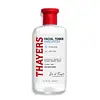What's inside
What's inside
 Key Ingredients
Key Ingredients

No key ingredients
 Benefits
Benefits

 Concerns
Concerns

 Ingredients Side-by-side
Ingredients Side-by-side

Water
Skin ConditioningAlcohol Denat.
AntimicrobialHamamelis Virginiana Water
AstringentGlycereth-26
HumectantNiacinamide
SmoothingCoceth-7
EmulsifyingTrideceth-9
EmulsifyingPPG-1-PEG-9 Lauryl Glycol Ether
EmulsifyingPEG-5 Ethylhexanoate
EmulsifyingSorbitol
HumectantCamellia Sinensis Leaf Extract
AntimicrobialPanthenol
Skin ConditioningSodium Citrate
BufferingPEG-40 Hydrogenated Castor Oil
EmulsifyingPhenoxyethanol
PreservativeLavandula Angustifolia Oil
MaskingDisodium EDTA
Salicylic Acid
MaskingOrmenis Multicaulis Oil
MaskingRosmarinus Officinalis Leaf Oil
MaskingSalvia Officinalis Oil
MaskingBenzoic Acid
MaskingCitric Acid
BufferingLinalool
PerfumingLimonene
PerfumingWater, Alcohol Denat., Hamamelis Virginiana Water, Glycereth-26, Niacinamide, Coceth-7, Trideceth-9, PPG-1-PEG-9 Lauryl Glycol Ether, PEG-5 Ethylhexanoate, Sorbitol, Camellia Sinensis Leaf Extract, Panthenol, Sodium Citrate, PEG-40 Hydrogenated Castor Oil, Phenoxyethanol, Lavandula Angustifolia Oil, Disodium EDTA, Salicylic Acid, Ormenis Multicaulis Oil, Rosmarinus Officinalis Leaf Oil, Salvia Officinalis Oil, Benzoic Acid, Citric Acid, Linalool, Limonene
 Reviews
Reviews

Ingredients Explained
These ingredients are found in both products.
Ingredients higher up in an ingredient list are typically present in a larger amount.
Citric Acid is an alpha hydroxy acid (AHA) naturally found in citrus fruits like oranges, lemons, and limes.
Like other AHAs, citric acid can exfoliate skin by breaking down the bonds that hold dead skin cells together. This helps reveal smoother and brighter skin underneath.
However, this exfoliating effect only happens at high concentrations (20%) which can be hard to find in cosmetic products.
Due to this, citric acid is usually included in small amounts as a pH adjuster. This helps keep products slightly more acidic and compatible with skin's natural pH.
In skincare formulas, citric acid can:
While it can provide some skin benefits, research shows lactic acid and glycolic acid are generally more effective and less irritating exfoliants.
Most citric acid used in skincare today is made by fermenting sugars (usually from molasses). This synthetic version is identical to the natural citrus form but easier to stabilize and use in formulations.
Read more about some other popular AHA's here:
Learn more about Citric AcidPhenoxyethanol is a preservative that has germicide, antimicrobial, and aromatic properties. Studies show that phenoxyethanol can prevent microbial growth. By itself, it has a scent that is similar to that of a rose.
It's often used in formulations along with Caprylyl Glycol to preserve the shelf life of products.
Water. It's the most common cosmetic ingredient of all. You'll usually see it at the top of ingredient lists, meaning that it makes up the largest part of the product.
So why is it so popular? Water most often acts as a solvent - this means that it helps dissolve other ingredients into the formulation.
You'll also recognize water as that liquid we all need to stay alive. If you see this, drink a glass of water. Stay hydrated!
Learn more about Water